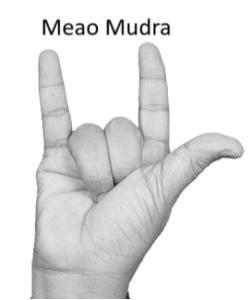Meao Mudra
Introduction
Meao Mudra is a specialized hand gesture used in yoga and Ayurvedic mudra therapy, especially for regulating blood pressure. It’s valued for its ability to balance both high and low blood pressure, earning it the reputation as a stabilizing practice for cardiovascular health.
Meaning
The name “Meao” doesn’t appear to derive from traditional Sanskrit nomenclature; it seems to be a contemporary designation within modern wellness practices. Despite this, the mudra itself is deeply therapeutic, particularly in balancing the earth element within the body, which can stabilize blood pressure fluctuations.
How to Perform (Practice)
Sit in a comfortable meditative posture with a straight spine—this can be Sukhasana, Padmasana, Vajrasana, or a seated chair position.
To perform this Mudra, make a fist with both the hands, fingers really digging into the center of the palm.
Now open up the index, little finger and the thumb, keeping them reasonably straight. Rest the hands on the knee facing up by keeping the elbow straight.
Close your eyes and breathe deeply. Hold this position for 10–15 minutes per session, up to three times daily, or cumulatively up to 45 minutes per day.
Benefits
Regulates blood pressure effectively, whether readings are too high or too low.
Supports overall heart health and improved circulation.
Contraindications
Those with high Kapha constitution or who desire elevation of earth energy are advised to exercise caution, as it may aggravate stagnation or lethargy.
As with all practices affecting cardiovascular dynamics, consult a healthcare provider if you have serious heart conditions or are on medication for blood pressure.
Anatomy & Physiology
Though there’s no direct scientific evidence cited, the mudra is believed to influence autonomic regulation, helping stabilize cardiovascular output and manage vasomotor tone—thereby aiding in blood pressure balance.
Kinesiology
The specific folding of the middle and ring fingers may subtly stimulate hand nerve endings and acupuncture points, influencing subtle pranic flow, but no formal biomechanics studies were found.
Neurology
Gentle hand postures like this can engage the parasympathetic nervous system, calming stress responses and supporting heart rate variability—key for blood pressure regulation.
Duration of Practice
Standard: 10–15 minutes per session, up to three times daily.
Maximum: Up to 45 minutes in total per day, with flexibility as needed.
Counter Mudra
While not explicitly stated in the sources, commonly recommended balancing mudras for cardiovascular concerns include:
Prana Mudra for vitality
Apana Mudra for grounding and detox
Vyana Mudra for balanced circulation
These might be used when feeling imbalanced due to prolonged Meao Mudra practice.

